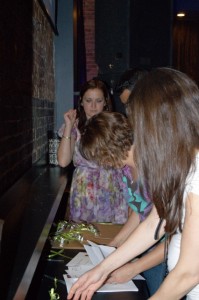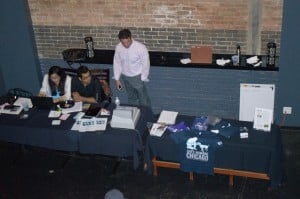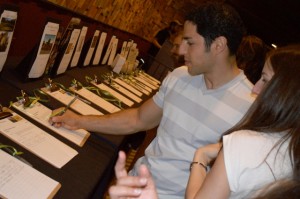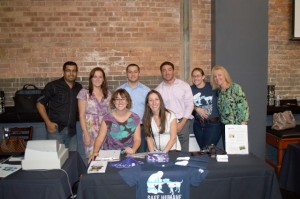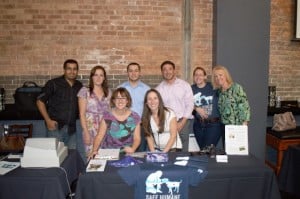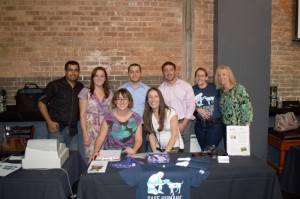Project Description-
Our project scope was to raise substantial funds as well as awareness for our desired charity, Safe Humane, through a fundraiser event held at a Bar/Restaurant that is willing to assist in our fundraising efforts. The location we selected was 27 Live in Evanston. Our main goal was to raise money through tickets sales, food and liquor sales at the event, on-site auctions and charitable donations donated at the event or online through Eventbrite. Our event took place at 27 Live Restaurant & Bar on Thursday, July 31st. 27 Live donated the space and staff, and provided unlimited appetizers for the duration of the event for a reduced per-person fee. This greatly reduced our costs to hold the event. As mentioned above, we also had an online fundraising site established to ensure that individuals who are not able to make it to the event but wished to contribute to the cause had a method to do so. We were able to push the message through social media and our personal and professional contacts as we marketed the main event to reach the largest possible group. We had a live band at our event to provide a pleasant environment where people want to attend, stay, have fun, and potentially donate more through the silent auction. The band was John McHugh & Company. We reached out to local dog-based vendors to have them come out to our event and get visibility with their potential future clients. Most were unwilling to do so, but provided some silent auction items. We held a very successful silent auction at the event raising $2000 additional funds for the charity. Various vendors, our employers, and family and friends donated items for the silent auction. In addition to the above, we partnered with Safe Humane to volunteer at the Taste of Lincoln Beer Tent. Members of our team volunteered our time at the beer tent to help Safe Humane raise the highest possible funds. The contributions we raised through tips during this event were accounted in our total proceeds raised for Safe Humane.
Project Success Metrics-
Overall our team did very well base on the metrics we decided to use at the beginning of the project. We raised a total of 5793 which was at the higher end of what we expected. One of our goals was to keep costs low so we could donate as much of our revenue to the charity that we could. The number of donors we calculated only took into consideration the number of entries on our site. The number is realistically higher but we didn’t take into consideration those who we couldn’t track as well as those who donated multiple time or through multiple avenues. The average gift size of 55.4 was much higher than the cost of an individual ticket for the event which is a reflections on the success we had through the silent auction. On the efficiency front we were able to generate a dollar of profit for every $.30 of expenses. None of the expenses were paid out of pocket. The expenses were the profit sharing we had to give the bar for allowing us to use their facilities. Profitability for this project was excellent with a return on investment of 339%. If a project like this was available for investors, they would gladly jump all over it.
Advice for Future Teams
As you embark on choosing your own project, there are several things to keep in mind. First, it is important to have one of the team members that is truly passionate about particular charity and have ties to it. One of our team members volunteered for Safe Humane as result has strong ties. When it came to leverage charity’s network and getting their overall support, we already had that connection and it made things less stressful. Second, it is important to think broad about how you plan to support the charity meaning what type of fundraising activity you would like to do. While it is good to think big, it is also important to be realistic. Since our class had only 10 weeks, it was important to be realistic about the timeframe that you have and what you can accomplish. Some of the fundraising ideas we had included things like special permits, which take long time to obtain. Think big, share ideas with your team and vote on the best option that you can come up with. Third, it is important to have several ways for your network to donate. Some people may not be able to attend the event you are hosting, but would love to be able to donate money to your cause. We used online website called eventbrite, which offerred several options including ability to sell tickets to the event as well as collect plain donations. In addition, you are able to easily share your donation website with your network via social network/email, etc which brings up next point. Fourth, social media is critical part of your marketing plan. It is important to leverage it because it is effective and free. Our charity also had strong following on Facebook and shared our event to help generate excitement and in turn donations. Lastly, it is important to tap into your network and business community for support. Share your fundraiser info with your family, friends and do it often leading up to the event. People forget to donate, therefore it is important to keep it on the top of their mind. In addition, introduce yourself to your local area businesses. They are looking to promote their lines of business and donating to your fundraiser is a business opportunity. It is important to have good sales pitch, but just plain ask.
Lessons Learned
There are many lessons learned from doing a project such as the one we have done, however there are 2 critical lessons learned that our team walked away with.
- Importance of Project Management– During the course of project, it became very evident the critical role our project manager played in making sure we have a successful project. During the class, you will learn many skills that are required to become a good project manager. When doing a project in practice like we have, our project manager was very organized, broke down our work structure, created timelines, held weekly calls to ensure timely execution and strong follow thru. In business world, you would hope to have strong project managers to do the same thing on the projects you are working.
- Risk Management Plan – If you don’t have a risk management plan, you are probably likely going to experience some hard time. When we were compiling risk management plan, we didn’t think that certain things would happen. However, we quickly realized the importance of risk management plan. Expect the unexpected and be prepared to think quickly on your feet. Whenever you start a project, it is important to identify potentially risks and propose how you plan to address those risks. It is critical to identify all risks, ways you would address them and proceed with your plan.
Photos from our Project



